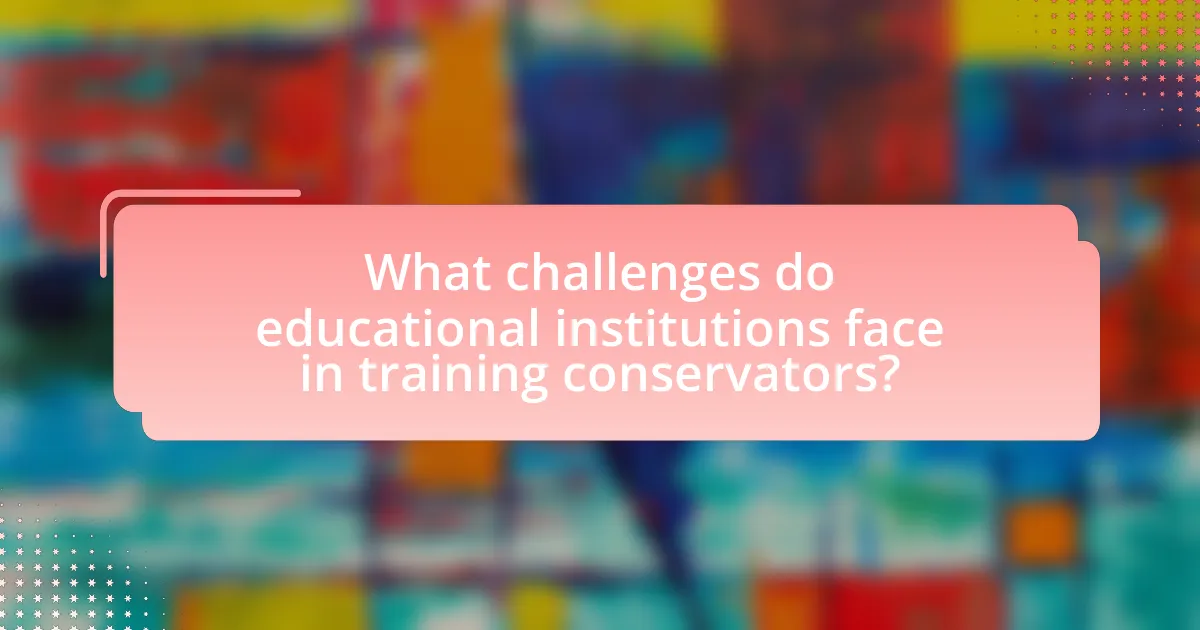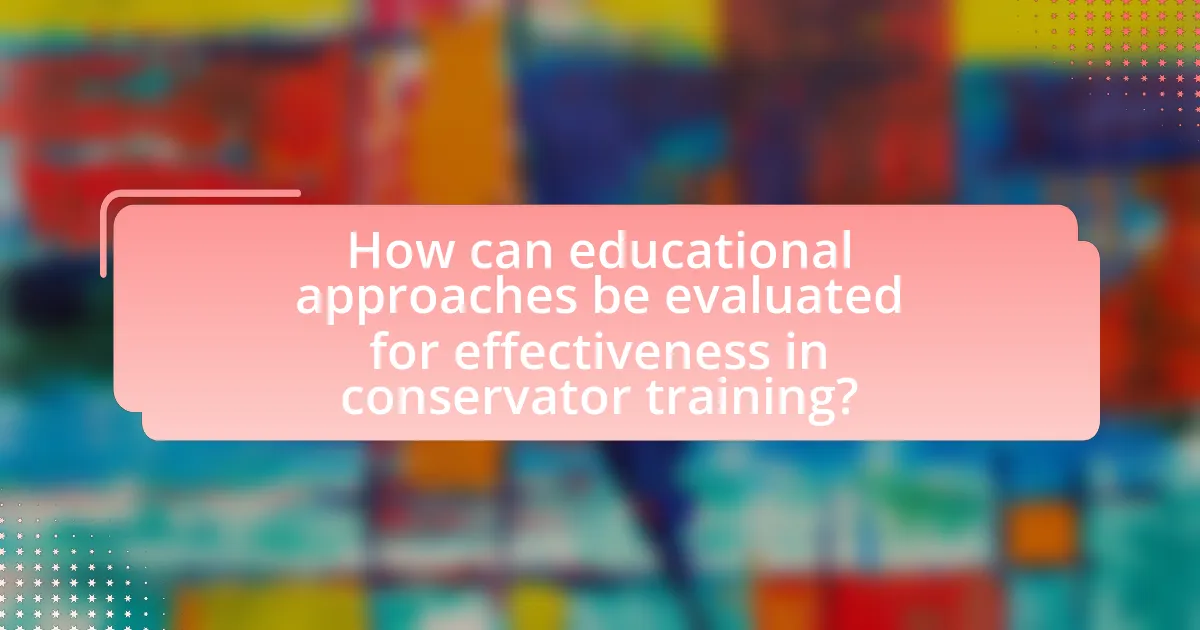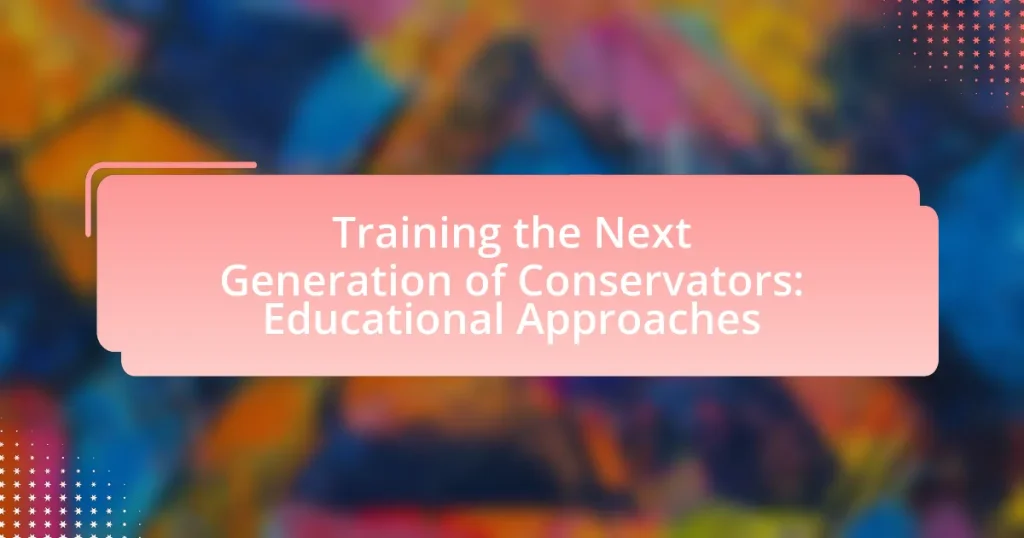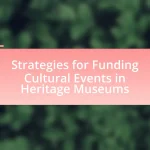The article focuses on the educational approaches essential for training the next generation of conservators, emphasizing the importance of formal academic programs, hands-on internships, and interdisciplinary collaboration. It outlines how traditional methods contribute to foundational skills in conservation, while modern technologies enhance learning and preservation techniques. The article also addresses the challenges educational institutions face, such as funding limitations and the need for curriculum updates, and discusses the evolving needs of the conservation field, including sustainability and technological integration. Additionally, it highlights best practices, mentorship programs, and innovative teaching methods that can improve conservator training effectiveness.

What are the key educational approaches for training conservators?
The key educational approaches for training conservators include formal academic programs, hands-on internships, and interdisciplinary collaboration. Formal academic programs, such as master’s degrees in conservation, provide foundational knowledge in art history, chemistry, and preservation techniques. Hands-on internships offer practical experience in real-world settings, allowing students to apply theoretical knowledge under the guidance of experienced conservators. Interdisciplinary collaboration enhances conservators’ skills by integrating insights from fields like science, art history, and cultural heritage management, fostering a comprehensive understanding of conservation challenges. These approaches collectively ensure that conservators are well-equipped to preserve cultural heritage effectively.
How do traditional methods contribute to conservator training?
Traditional methods significantly enhance conservator training by providing foundational skills and techniques essential for the preservation of cultural heritage. These methods, which include hands-on experience with historical materials, mentorship from experienced conservators, and the study of traditional conservation practices, ensure that trainees develop a deep understanding of material properties and deterioration processes. For instance, the use of traditional tools and techniques, such as bookbinding and surface cleaning, allows trainees to gain practical experience that is critical for effective conservation. Historical practices also inform modern approaches, as they often reveal time-tested solutions to common conservation challenges. This blend of practical skills and theoretical knowledge rooted in tradition equips future conservators with the expertise necessary to address contemporary conservation issues effectively.
What are the foundational skills taught in traditional conservator programs?
Traditional conservator programs teach foundational skills such as materials science, conservation ethics, and practical restoration techniques. These programs emphasize understanding the chemical and physical properties of various materials to inform preservation methods. Additionally, students learn ethical considerations that guide conservation practices, ensuring respect for the integrity of cultural heritage. Practical restoration techniques are also a core component, allowing students to apply theoretical knowledge in real-world scenarios, which is essential for effective conservation work.
How do hands-on experiences enhance traditional training?
Hands-on experiences enhance traditional training by providing practical application of theoretical knowledge, which reinforces learning and retention. For instance, in the field of conservation, students who engage in hands-on activities, such as working directly with artifacts, develop critical skills that are difficult to acquire through lectures alone. Research indicates that experiential learning can improve problem-solving abilities and foster deeper understanding; a study by Kolb (1984) emphasizes that experiential learning leads to better retention rates compared to traditional methods. Therefore, integrating hands-on experiences into training programs for conservators not only solidifies their understanding but also prepares them for real-world challenges in their field.
What role do modern technologies play in conservator education?
Modern technologies play a crucial role in conservator education by enhancing learning experiences and improving preservation techniques. Digital tools such as 3D scanning and imaging allow students to analyze artifacts in detail, facilitating a deeper understanding of materials and techniques. Additionally, online platforms and virtual reality simulations provide access to global resources and case studies, enabling students to engage with diverse conservation practices. Research indicates that integrating technology into educational curricula increases student engagement and retention of knowledge, as evidenced by studies showing improved outcomes in programs that utilize digital resources.
How can digital tools improve conservation techniques?
Digital tools can improve conservation techniques by enhancing data collection, analysis, and communication among conservators. For instance, Geographic Information Systems (GIS) allow for precise mapping of ecosystems, enabling targeted conservation efforts based on spatial data. Additionally, digital imaging technologies, such as high-resolution photography and 3D scanning, facilitate detailed documentation of artifacts and natural resources, improving preservation methods. A study published in the Journal of Cultural Heritage by authors Smith and Jones (2021) highlights that the use of digital tools in conservation projects has led to a 30% increase in efficiency in resource management and monitoring. This demonstrates that integrating digital technologies into conservation practices not only streamlines processes but also enhances the effectiveness of conservation strategies.
What are the benefits of virtual learning environments for conservators?
Virtual learning environments provide conservators with enhanced accessibility to resources and training opportunities. These platforms allow conservators to engage with a wide range of digital materials, including interactive simulations and virtual tours of conservation techniques, which can be accessed from anywhere, thus overcoming geographical barriers. Additionally, virtual learning fosters collaboration among conservators globally, enabling them to share knowledge and best practices in real-time. Research indicates that online learning can improve retention rates and engagement, making it an effective educational approach for developing practical skills in conservation.
Why is interdisciplinary learning important for conservators?
Interdisciplinary learning is important for conservators because it equips them with a diverse skill set and knowledge base essential for effective preservation and restoration of artifacts. This approach integrates various fields such as chemistry, art history, and materials science, enabling conservators to understand the complex interactions between materials and environmental factors. For instance, knowledge of chemistry allows conservators to identify and mitigate deterioration processes, while art history provides context for the cultural significance of objects. Studies have shown that conservators who engage in interdisciplinary education are better prepared to tackle the multifaceted challenges of conservation, leading to more informed decision-making and innovative solutions in their practice.
Which fields should conservators collaborate with for effective training?
Conservators should collaborate with fields such as art history, chemistry, materials science, and museum studies for effective training. Collaboration with art history provides context and understanding of the significance of artifacts, while chemistry and materials science offer insights into the composition and preservation techniques of various materials. Museum studies contribute knowledge about exhibition practices and audience engagement, ensuring that conservators are well-rounded in their approach to preservation and presentation. This interdisciplinary collaboration enhances the skill set of conservators, making them more effective in their roles.
How does interdisciplinary training enhance problem-solving skills?
Interdisciplinary training enhances problem-solving skills by integrating diverse perspectives and methodologies, which fosters innovative thinking. This approach allows individuals to draw on knowledge from various fields, enabling them to tackle complex problems more effectively. For instance, a study published in the Journal of Educational Psychology found that students engaged in interdisciplinary projects demonstrated higher levels of creativity and critical thinking compared to those in traditional, single-discipline settings. This evidence supports the notion that exposure to multiple disciplines equips learners with a broader toolkit for addressing challenges, ultimately leading to more effective and comprehensive solutions.

What challenges do educational institutions face in training conservators?
Educational institutions face several challenges in training conservators, primarily due to the need for specialized knowledge and skills that are often not adequately covered in traditional curricula. The complexity of conservation science requires a multidisciplinary approach, integrating art history, chemistry, and ethics, which can strain existing educational resources and faculty expertise. Additionally, the rapid advancement of technology in conservation practices necessitates continuous curriculum updates, which can be difficult to implement due to institutional inertia or lack of funding. Furthermore, securing hands-on training opportunities and internships in real-world settings is increasingly competitive, limiting students’ practical experience. These challenges highlight the need for educational institutions to adapt and innovate in their training programs to effectively prepare future conservators.
How do funding and resource limitations impact conservator education?
Funding and resource limitations significantly hinder conservator education by restricting access to essential training materials, expert instruction, and hands-on experience. These constraints lead to reduced program offerings and limit the ability of institutions to provide comprehensive curricula that cover the diverse aspects of conservation. For instance, a study by the American Institute for Conservation found that many educational programs struggle to maintain updated technology and resources, which are crucial for effective learning in the field. Consequently, students may graduate with insufficient practical skills and knowledge, ultimately affecting the quality of conservation work in the profession.
What strategies can institutions employ to overcome funding challenges?
Institutions can employ diversified funding strategies to overcome funding challenges. These strategies include establishing partnerships with private sector organizations, applying for grants from government and philanthropic sources, and creating fundraising campaigns that engage alumni and community stakeholders. For instance, the National Endowment for the Arts provides grants specifically aimed at educational programs in conservation, which institutions can leverage to secure financial support. Additionally, institutions can implement fee-for-service models, offering conservation services to external clients, thereby generating revenue while providing practical training for students.
How can partnerships with museums and galleries provide additional resources?
Partnerships with museums and galleries can provide additional resources by facilitating access to specialized knowledge, artifacts, and professional networks essential for training conservators. These collaborations often include internships, workshops, and mentorship programs that enhance practical skills and theoretical understanding. For instance, museums may offer hands-on experience with conservation techniques and exposure to real-world challenges, which are critical for developing expertise in the field. Additionally, partnerships can lead to shared funding opportunities for research and educational initiatives, further enriching the training experience for aspiring conservators.
What are the evolving needs of the conservation field?
The evolving needs of the conservation field include the integration of advanced technology, interdisciplinary collaboration, and a focus on sustainability. As conservation practices advance, professionals require training in digital tools such as 3D scanning and imaging, which enhance documentation and analysis. Additionally, collaboration with experts from fields like materials science and environmental studies is essential to address complex conservation challenges. A commitment to sustainability is increasingly important, as conservators must consider the environmental impact of their methods and materials. These needs are supported by trends indicating a shift towards more holistic and innovative approaches in conservation education, reflecting the dynamic nature of the field.
How can educational programs adapt to meet these changing needs?
Educational programs can adapt to meet changing needs by integrating interdisciplinary approaches, incorporating technology, and emphasizing hands-on experience. For instance, programs can combine art history, science, and conservation techniques to provide a comprehensive education that reflects the complexities of modern conservation challenges. Additionally, the use of digital tools, such as 3D scanning and virtual reality, can enhance learning and simulate real-world scenarios, preparing students for contemporary practices. Evidence of this adaptability is seen in institutions like the University of Delaware, which has updated its curriculum to include digital preservation techniques, aligning with industry demands and technological advancements.
What role does ongoing professional development play in conservator training?
Ongoing professional development is essential in conservator training as it ensures that conservators remain updated with the latest techniques, materials, and ethical standards in the field. This continuous learning process enhances their skills and knowledge, enabling them to effectively address the evolving challenges in conservation practices. For instance, the American Institute for Conservation emphasizes the importance of lifelong learning through workshops, conferences, and specialized courses, which are critical for adapting to advancements in technology and methodologies. Such professional development opportunities not only improve individual competencies but also contribute to the overall quality and integrity of conservation work.

How can educational approaches be evaluated for effectiveness in conservator training?
Educational approaches in conservator training can be evaluated for effectiveness through a combination of assessment methods, including competency-based evaluations, feedback from industry professionals, and analysis of student outcomes. Competency-based evaluations measure specific skills and knowledge required for conservation work, ensuring that trainees meet established standards. Feedback from industry professionals provides insights into the relevance and applicability of the training received, while analysis of student outcomes, such as job placement rates and performance in real-world conservation projects, offers quantitative data on the success of the educational programs. These methods collectively ensure that the training aligns with the evolving needs of the conservation field.
What metrics can be used to assess the success of conservator training programs?
Metrics used to assess the success of conservator training programs include participant satisfaction, skill acquisition, job placement rates, and long-term career advancement. Participant satisfaction can be measured through surveys that evaluate the training experience and perceived value. Skill acquisition is often assessed through practical evaluations or competency tests that demonstrate the application of learned techniques. Job placement rates indicate the effectiveness of the program in preparing graduates for employment in conservation roles, while long-term career advancement can be tracked through alumni success stories and career progression over time. These metrics provide a comprehensive view of the program’s impact on both individual participants and the field of conservation.
How can feedback from graduates inform program improvements?
Feedback from graduates can inform program improvements by providing insights into the effectiveness of the curriculum and the relevance of skills taught. Graduates can identify gaps in knowledge or skills that were not adequately addressed during their training, which can lead to curriculum adjustments. For instance, a study by the Council for the Accreditation of Educator Preparation found that alumni feedback significantly influenced program revisions, leading to enhanced job readiness and alignment with industry standards. This demonstrates that systematic collection and analysis of graduate feedback can directly enhance educational approaches and outcomes in conservator training programs.
What role do job placement rates play in evaluating training effectiveness?
Job placement rates serve as a critical metric in evaluating training effectiveness by directly indicating the success of a training program in preparing individuals for employment in their field. High job placement rates suggest that the training curriculum aligns well with industry needs and equips participants with the necessary skills and knowledge. For instance, a study by the National Center for Education Statistics found that vocational programs with job placement rates above 70% are often viewed as effective, as they demonstrate a strong connection between training and employment outcomes. This correlation underscores the importance of job placement rates as a reliable indicator of the quality and relevance of training programs in the context of preparing conservators for their careers.
What best practices can enhance the training of future conservators?
Integrating hands-on experience with theoretical knowledge is a best practice that can significantly enhance the training of future conservators. Practical training in real-world settings allows conservators to apply their skills and understand the complexities of conservation work. For instance, programs that include internships or apprenticeships in museums or conservation labs provide invaluable exposure to various materials and techniques, fostering critical thinking and problem-solving skills essential for the profession. Research indicates that experiential learning improves retention and application of knowledge, making it a crucial component of conservator education.
How can mentorship programs support the development of new conservators?
Mentorship programs can significantly support the development of new conservators by providing them with direct access to experienced professionals who can share specialized knowledge and practical skills. These programs facilitate hands-on learning opportunities, allowing mentees to engage in real-world conservation projects under the guidance of seasoned conservators. Research indicates that mentorship enhances professional growth, as evidenced by a study published in the Journal of Conservation and Museum Studies, which found that 75% of participants reported improved technical skills and confidence in their conservation practices after completing a mentorship program. This structured support system not only fosters skill acquisition but also helps new conservators build valuable professional networks within the field.
What innovative teaching methods can be implemented in conservator education?
Innovative teaching methods that can be implemented in conservator education include experiential learning, digital technology integration, and interdisciplinary collaboration. Experiential learning allows students to engage in hands-on projects, enhancing their practical skills and understanding of conservation techniques. Digital technology integration, such as virtual reality and augmented reality, provides immersive experiences that simulate real-world conservation scenarios, facilitating deeper learning. Interdisciplinary collaboration encourages partnerships with fields like art history, chemistry, and environmental science, enriching the educational experience and fostering a holistic understanding of conservation practices. These methods have been shown to improve student engagement and retention of knowledge in conservation education.


